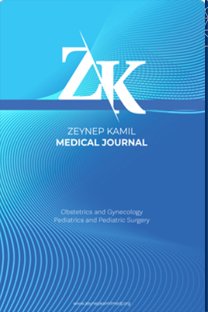Ectopic pelvic kidney: Prenatal diagnosis and management
Ectopic pelvic kidney: Prenatal diagnosis and management
___
- 1. Guarino N, Tadini B, Camardi P, Silvestro L, Lace R, Bianchi M. The incidence of associated urological abnormalities in children with renal ectopia. J Urol 2004;172(4):1757–9; discussion 1759.
- 2. Meizner I, Barnhard Y. Bilateral fetal pelvic kidneys: Documentation of two cases of a rare prenatal finding. J Ultrasound Med 1995;14(6):487– 9.
- 3. Sheih CP, Liu MB, Hung CS, Yang KH, Chen WY, Lin CY. Renal abnormalities in schoolchildren. Pediatrics 1989;84(6):1086–90.
- 4. Yuksel A, Batukan C. Sonographic findings of fetuses with an empty renal fossa and normal amniotic fluid volume. Fetal Diagn Ther 2004;19(6):525–32.
- 5. Nguyen HT, Benson CB, Bromley B, Campbell JB, Chow J, Coleman B, et al. Multidisciplinary consensus on the classification of prenatal and postnatal urinary tract dilation (UTD classification system). J Pediatr Urol 2014;10(6):982–98.
- 6. Boer DP, de Rijke YB, Hop WC, Cransberg K, Dorresteijn EM. Reference values for serum creatinine in children younger than 1 year of age. Pediatr Nephrol 2010;25(10):2107–13.
- 7. Hill LM, Grzybek P, Mills A, Hogge WA. Antenatal diagnosis of fetal pelvic kidneys. Obstet Gynecol 1994;83(3):333–6.
- 8. Meizner I, Yitzhak M, Levi A, Barki Y, Barnhard Y, Glezerman M. Fetal pelvic kidney: A challenge in prenatal diagnosis? Ultrasound Obstet Gynecol 1995;5(6):391–3.
- 9. Arena F, Arena S, Paolata A, Campenni A, Zuccarello B, Romeo G. Is a complete urological evaluation necessary in all newborns with asymptomatic renal ectopia? Int J Urol 2007;14(6):491–5.
- 10. Sagi-Dain L, Singer A, Frumkin A, Shalata A, Koifman A, Segel R, et al. Chromosomal microarray findings in pregnancies with an isolated pelvic kidney. J Perinat Med 2018;47(1):30–4.
- 11. Bingham G, Leslie SW. Pelvic kidney. In: Stat Pearls. Treasure Island,FL: Stat Pearls Publishing; 2020.
- 12. Calisti A, Perrotta ML, Oriolo L, Ingianna D, Miele V. The risk of associated urological abnormalities in children with pre and postnatal occasional diagnosis of solitary, small or ectopic kidney: Is a complete urological screening always necessary? World J Urol 2008;26(3):281–4.
- 13. Gleason PE, Kelalis PP, Husmann DA, Kramer SA. Hydronephrosis in renal ectopia: Incidence, etiology and significance. J Urol 1994;151(6):1660–1.
- 14. Cinman NM, Okeke Z, Smith AD. Pelvic kidney: Associated diseases and treatment. J Endourol 2007;21(8):836–42.
- 15. Downs RA, Lane JW, Burns E. Solitary pelvic kidney. Its clinical implications. Urology 1973;1(1):51–6.
- ISSN: 1300-7971
- Yayın Aralığı: Yılda 4 Sayı
- Yayıncı: Ali Cangül
Anxiety, quality of life, eating behaviors, and sexual life in women with polycystic ovary syndrome
Gülfem BAŞOL, Sevil KİREMİTLİ, Tunay KİREMİTLİ, Paşa ULUĞ, Kemine UZEL
Funda GÜNGÖR UĞURLUCAN, Cenk YAŞA, Sina ARMAN, Ekin İlke ŞEN, Nalan ÇAPAN, Gülşah GULA, Ayşe KARAN
Effects of topical Povidone-iodine on thyroid function in surgical newborns
Ayşenur CELAYİR, Sırma Mine TİLEV, Burcu ARI, Tuba ERDEM
An overview of anaphylaxis in children
Fırat TÜLEK, Bülent Berker, Alper KAHRAMAN
Evaluation of blood pressures measured at the clinic and during exercise test in children
Nurdan EROL, Çiğdem EROL, İlke AKTAŞ
Ectopic pelvic kidney: Prenatal diagnosis and management
Gürcan TÜRKYILMAZ, Bilal ÇETİN
External anal sphincter repair by the overlapping method in obstetric anal sphincter injury syndrome
Filiz AKYÜZ, Sami AÇAR, Erman ÇİFTÇİ
Seroprevalence of Varicella-Zoster in the first trimester of pregnancy
